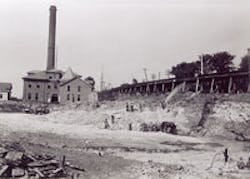About the author: Randy Moore is president of Iowa American Water. Moore can be reached at 563.468.9218.
Critical infrastructure components, including two flocculator buildings and flocculation equipment, were aging and in need of replacement at the East River Station Water Treatment Plant (WTP) in Davenport, Iowa. Originally constructed in 1956 and 1965, respectively, replacement was necessary to handle exterior exposure and associated winter ice formation that had been problematic in the past.
Despite record-breaking cold and snowfall— plus one of the Quad Cities’ worst floods on the Mississippi River, which halted work on the project for two months—Iowa American Water completed an approximately $2.6-million improvement of East River Station’s flocculation and sedimentation processes. The project enhanced the plant’s water treatment process, which provides drinking water to approximately 51,000 customers in the Iowa Quad Cities. Additionally, it helped decrease maintenance costs and improved treatment efficiency and reliability.
Project Details
The flocculation process follows chemical coagulation or mixing and is used to bring the coagulated particles together to form floc, which is larger and more easily removed from the subsequent settling and filtration treatment processes. The East River Station project involved removal and replacement of the old walking-beam flocculation equipment, originally installed in 1956, and demolition of the two flocculation buildings, originally constructed in 1965.
In addition, major structural modifications were completed on the flocculation and sedimentation structures, originally constructed in 1901. The old flocculators, which required installation within buildings, have been replaced with a series of three vertical impeller-type mixers installed in each of the two flocculator tanks. These new mixers, along with a reconfiguration of both the flocculation and sedimentation treatment processes, optimize efficiency.
The flocculation stage improved with variable- speed mixers installed within three baffled chambers of each flocculator. The variable-speed mixers allow for adjustment of mixer speed seasonally or as water quality changes to allow for optimized treatment. Baffled inlets and new submerged orifice collection launders were installed in the sedimentation basins to provide even flow distribution and collection. The rated capacity of the flocculation/sedimentation process is 15 million gal a day (mgd).
Overall, the improvements allowed the flocculation/sedimentation treatment process to respond better to changing flows within the process, pro- viding a more consistent level of treatment with a more efficient use of treatment chemicals. The updates also allow the basins to better handle winter weather and associated ice formation, as the old basins were maintenance-intensive; during cold-weather months, plant workers had to spend countless hours working to remove ice, which could freeze equipment and ultimately stop production if not broken up.
Unexpected Challenges
Extremely cold temperatures and icing within the basins presented major construction challenges throughout the winter. After the first phase of the project was put into temporary service in March 2011, high river levels and subsequent flooding in April caused a two-month project delay.
The first phase of the project was put into full service in early June. The second phase, which included modifications to the sedimentation basin, experienced delays because flooding put the basin out of service through the extended high pump- age period in mid-July. High flows in excess of 28 mgd—not seen since the summer of 2006—challenged the treatment process, but the remaining basin and two Superpulsator clarifiers continued to provide high-quality water, meeting or exceeding all federal and state water quality standards. Normal operation of the process resumed on July 25, 2011, with the basin in service.
Quality Standards
East River Station’s high-tech WTP uses some of the best equipment and technology available to the water industry. The source of supply is the Mississippi River, and treatment entails conventional coagulation and settling processes and parallel Superpulsator clarification, followed by granular activated carbon filtration. The granulated activated carbon filtration process is cited by the U.S. Environmental Protection Agency (EPA) as one of the most effective treatment technologies for the removal of organic chemicals, such as farm pesticides and industrial wastes. It also is highly effective in eliminating many taste and odor problems.
In 2010, Iowa American Water was awarded the prestigious Ten-Year Directors Award under the Partnership for Safe Water program administered by the EPA, Iowa Department of Natural Resources and other water-related organizations. The award honors water utilities for achieving operational excellence by voluntarily optimizing their treatment facility operations and adopting more stringent performance goals than those required by federal and state drinking water standards. Iowa American Water joined the partnership in 1995 and remains one of only three utilities in the state to participate. The Quad Cities District was the first water utility in Iowa to be given the Directors Award and remains the only Iowa water utility to receive this recognition.
Download: Here
